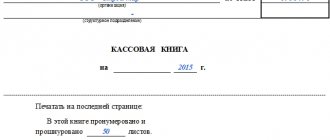By law, companies that accept payments for goods, services or work in the form of cash must use cash registers in their activities. Moreover, each transaction recorded with the participation of the cash desk is confirmed by a paper check, which contains the following data: number, date and essence of the transaction, as well as the amount that was spent on it.
All actions performed over a certain period of time using a cash register are included in the cashier-operator’s journal.
- Form and sample
- Online viewing
- Free download
- Safely
FILES
What goals and objectives does the document solve?
The journal is a means of recording all transactions performed using a cash register. It contains information about both the receipt and expenditure of funds.
In cases where an organization has several cash registers, a journal is kept for each of them separately.
Generally speaking, having a magazine allows you to solve several different problems at once. For example, with the help of a journal, the head of an enterprise can quickly determine at any time how much money passed through the cash register for a specific period, and tax service employees, during inspections, have the opportunity to quickly compare cash register readings and figures from reporting documents with information from the journal.
Do I need to register?
Like a cash register, the journal must be registered with the tax authorities.
Even the first filling of the journal occurs at the same time as the cash register is registered (the inspector punches a check with the amount of 1 ruble 11 kopecks - this value is not subsequently taken into account by either accountants or tax authorities).
To ensure that the inspector does not refuse to register a cash register, a number of other documents must be provided along with the device itself and the magazine:
- application requesting registration of the cash register;
- certificate of a legal entity or individual entrepreneur;
- KKM passport;
- rental agreement for retail space (if the company does not have its own square meters);
- cash register service agreement concluded with a specialized center, etc.
A complete list of documents can be obtained from the territorial tax service.
What is the penalty for not having a cashier-operator’s journal?
Keeping a journal is a legal requirement, so inspectors during on-site tax audits must look at its presence and content. Failure to register a journal may result in a fine (although this penalty is not specified in the law).
It should be noted that conflicts often occurred between business representatives and tax authorities on this issue, leading to court. And, as practice has shown, the administrative penalty for the fact that the enterprise did not keep a log of the cashier-operator was removed from him in most cases.
Features of the document
Since 2013, unified templates for primary documents have been abolished, so today employees of organizations and enterprises have the opportunity to choose whether to keep a cashier-operator journal in free form, develop their own document form, or use the unified, previously mandatory form KM-4 . The majority, I must say, follow the third path, since the standard form contains all the necessary details and lines, which means there is no need to waste time on creating the structure and content of the journal.
The document should be kept in paper (printed) form. In this case, all its sheets must be numbered and fastened together using a thick thread (but not with a stapler). You can use a ballpoint pen of any dark color to fill out the journal (other writing tools - felt-tip pens, pencils, etc. are unacceptable).
On the last page of the document, you must indicate the number of sheets, put a stamp (unless, of course, the use of stamps is enshrined in the company’s accounting policy), and the signature of the responsible person (accounting department specialist or chief accountant).
Entries in the journal are made strictly chronologically (without gaps), while blots and errors are extremely undesirable.
If such an oversight does occur, the incorrect data should be corrected by carefully crossing out the incorrect information and entering the correct information, making o next to it. All adjustments must be dated and certified by the signature of the cashier-operator and the chief accountant.
The book can be maintained either on a regular basis (if a retail outlet or enterprise operates every day) or as needed.
If there were no transactions involving a cash register during the accounting period, you do not need to fill out the form.
Examples of some Z-reports and information on them for filling out the KM-4 form.
| Mercury 180K | Alpha 400K | Mercury 130K | Kasby 02K | AMC 100K |
Examples of filling out the Cashier-Operator Log on different cash registers:
Elwes-MK:
Is it necessary to fill out the cashier-operator’s logbook if nothing was punched at the checkout?
If the cash register did not display any amounts during the current day, then it is not necessary to make a report, especially since many cash registers do not allow you to make a Z-report. In a word, if you do not work on a cash register, then you do not need to fill out the cashier-operator log.
But, if you still want to write something down in the cashier-operator’s journal, then remove the zero check and make an evening Z-report, and then enter it in the cashier-operator’s journal.
When do you need to fill out the cashier-operator log?
The cashier-operator's journal is filled out immediately after the Z-report is taken. This can be once a day, for example in the evening - at the end of the working day. Or maybe your store is open around the clock and the shift ends in the morning, then the report is taken in the morning.
Is it possible to make several reports per day?
If you have two or three shifts per day, then you respectively take out two or three reports per day, but the most important thing is that each of the Z reports be entered as a separate line in the cashier-operator’s journal. This results in several records with the same date, but with different shift numbers.
If the cashier forgot to withdraw Z - report.
If the report was not taken in the evening, it doesn’t matter; it can be taken in the morning the next day or even the next day. In this case, in the cashier's journal, the operator needs to enter the date taken from the Z-report and spend the money on the date when it was withdrawn. Or, if the money has already been posted in the cash book, you can put the required date in the cashier’s journal, and ask the cashier to write an explanatory note in free form addressed to the director - this will force the cashier to be more careful next time.
If the cashier accidentally removed several extra reports during the day.
If several evening Z-reports for the day were accidentally taken at the cash register, then each one needs to be entered into the cashier-operator’s book separately; several reports will be issued under different numbers, but for the same date. Typically these are zero amount reports. You can also ask the cashier to write an explanation for educational purposes.
Is it possible to recover a lost Z-report?
Z - the report can be restored in two ways:
- Create a fiscal memory report. To do this, you need the tax inspector’s password; if you don’t know it, it’s better to call a cash register mechanic who will help you get the report. Do not try to remove the fiscal report yourself, as your cash register may be blocked if you enter the tax inspector's password incorrectly. The fiscal report will give you information only on the total amount for the day, that is, it will not contain information on each purchase for the day.
- Make a report on ECLZ . The EKLZ stores all information on all cash receipts punched on the cash register. That is, from the ECLZ block you can extract detailed information for any working day. Remember that the EKLZ block changes once a year, so information can only be obtained from the current block.
Corrections in the cashier's journal.
Each error in the cashier-operator's journal must be certified by the signature of the person responsible for maintaining the journal. That is, next to each correction you need to write: “believe the corrected one” and sign.
Are the cashier's journal and the cash book the same thing?
No. A cash book is another document that individual entrepreneurs and organizations are also required to have in order to maintain accounting records.
Fine for the absence of a cashier's journal.
Tax inspectors try from time to time to fine entrepreneurs for the absence or failure to fill out a cashier-operator's register, charging them under Article 15.1 of the Code of Administrative Offenses of the Russian Federation, and the fine under this article is rather large: from 40,000 to 50,000 rubles. So there were several court proceedings (one of them: No. A56-9691/2005 dated July 28, 2005), which entrepreneurs won each time. But how many entrepreneurs did not file a lawsuit against the illegal actions of tax officials remains a mystery. Therefore, decide for yourself whether you need to keep a journal or not.
And it looks completely ugly when tax inspectors try to bring the absence of a cashier-operator’s journal under Art. 14.5 Code of Administrative Offences. In my practice, there was one such case in the Leningrad region. The entrepreneur chose not to contact the tax authorities and paid a fine of 4,000 rubles. For organizations it would be 40,000 rubles.
There is also Article 120 of the Tax Code, which talks about gross violation of the rules for accounting for income and expenses. But failure to keep a journal for a cashier-operator is not a gross tax violation. Although some tax authorities also refer to this article when trying to put pressure on an entrepreneur so that he pays a fine.
Correctly filling out the cashier's journal will not save you from tax fines if you WANT to pay them))).
What should you do after filling out the cashier/operator log?
Prepare a certificate-report from the cashier and transfer the data to the cash book.
How to register a cashier's journal.
The cashier's journal is tied to a specific cash register. Therefore, the journal is registered along with the cash register registration. When the magazine comes to an end, you need to buy a new one, stitch it and number it, and then go to the tax office and have it certified. The certification of KM 4 journals is carried out by the operational control departments in the relevant Interdistrict Tax Inspectorate where the cash register was registered. The old completed log must be kept in the organization’s archives for 5 years. Although its storage became meaningless with the introduction of EKLZ - now all information is stored on electronic media.
Examples of a certified cashier's journal.
Where to register the cashier-operator's journal.
At the tax office - in the operational control department of the MIFTS (cash register registration department), in which the cash register was registered. For individual entrepreneurs - at the place of registration, and for organizations (LLC, OJSC, CJSC, etc.) at the place of registration of the enterprise or separate division.
Documents required for registering a new cashier-operator journal.
Different tax offices may have different rules regarding the documents presented. The law also does not specify the necessary documents for registering a replacement journal. In each specific case, it is better to call the tax office and ask what they want. Here are several types of documents that tax authorities in St. Petersburg require:
- passport (form) to the cashier.
- old journal of the cashier-operator.
- new cashier-operator's journal, stitched and numbered
- registration card for the cash register
- passport of the person presenting the documents and a power of attorney, if this is not the head of the enterprise.
First entry in the journal.
During the initial registration of the cashier-operator’s journal along with the cash register, the tax inspector makes the first entry in the journal, on the removed Z - a report and punched 1 ruble, 11 kopecks, although some tax authorities do not do this, but simply certify the journal with a signature and stamp.
An example of the first entry that the tax inspector leaves when registering the KM-4 journal.
The person responsible for maintaining the cashier-operator's journal.
Appointed by order of the director if the director does not want to be responsible for its maintenance. Usually this is a cashier, administrator or chief accountant. It would be a good idea for a manager to create a job description for a cashier-operator. In practice, no one fills out this column and tax inspectors do not find fault with it. If the column is not filled out, responsibility for maintaining it automatically falls on the head of the company or individual entrepreneur.
Types of cashier-operator journals.
I've met two types. Samples of cashier-operator logs:
- Vertical magazine. Pros: more lines on the page - enough for a larger number of records - less often you will have to change it at the tax office. Disadvantages: the columns are too narrow - large amounts do not fit.
- Horizontal magazine. Pros: easy to fill - wide lines that can accommodate large amounts. Cons: enough for fewer records - will have to be changed frequently.
How long does the cashier's journal last?
horizontal journal contains about 50 sheets and 20 lines on each sheet. 20 multiplied by 50 equals 1000, which means the magazine is enough for about a thousand days or shifts.
The vertical magazine has from 29 to 40 lines and 50 pages, that is, it is enough for about 2000 days (shifts).
You will notice that columns 6 and 9 are too narrow (especially in a vertical journal) to write large amounts of savings in them, and columns such as 5 and 15 are too wide for their meanings. Could Russian officials have come up with something smarter?
How to register a return in the cashier's journal.
Refunds at the cash desk are issued in column 15. If there were several returns for the current day, then they are all summed up and filled in with one amount. When returning, it is not necessary to punch out refund receipts at the checkout (although you can do this for beauty), but you must fill out the KM-3 form.
A detailed description of how to process a return can be found in this article.
An example of filling out a return in KM-4 (returns for a total amount of 1000, it does not matter how many returns there were): Please note that columns 11 (deposited in cash) and 14 (deposited in total) are less than the amount of returns.
Registration of sales by bank card / non-cash / credit
If you make sales using bank cards through bank terminals, or accept money through a checkbook, or by any other non-cash payment, then this money also needs to be entered at the cash register. In the evening Z-report you will have a separate line showing the number of sales by bank transfer and the total amount for the day by bank transfer. These two parameters must be written down in columns 12 and 13 of the cashier’s journal.
Columns 12 and 13 are responsible for breaking through funds not for cash payments - that is, by any other means:
- with a bank card - the entry of funds received through the bank terminal must occur twice: 1 - at the bank terminal itself 2 - at the cash register
- travelers checks
- sales on credit, etc.
There is no need to enter into the journal funds that were received into a non-cash bank account.
In column 12 - write the number of checks by bank transfer. Column 13 shows the total amount of checks by bank transfer. In column 11 - deposited in cash, the amount must be less than in column 14 by the amount in column 13, that is:
Sample document
At the beginning of the document, on the title, it is written:
- name of the organization, its address, as well as (on the right) codes: OKUD, OKPO, OKPD, INN number;
- The cash register on which the log is kept: its name (model, brand), numbers (manufacturer and registration);
- the period during which the information specified in it was entered into the journal;
- designate the employee responsible for creating the journal.
In the second part of the document, in the table, the following are entered in order:
- day-month-year of filling, and also, if the cash register operates in two shifts - shift number;
- department (here you can put dashes if the cash register serves one department, or enter all the department numbers to which the checks “went” during the current shift);
- Full name of the employee sitting at the cash register;
- serial number of the control counter at the time of shift delivery (i.e. serial number of the Z-report - its type depends on the cash register model);
- the values of the control counter, the amount of cash that has passed through the cash register since its registration with government agencies, plus the amount received during the current shift are recorded;
- The signature of the administrator and the cashier is immediately placed (if this is the same person, then you need to sign in both cells);
- the last column includes the amount of revenue for the previous day.
Next, enter into the form
- amount deposited in cash
- the amount returned to customers due to the fact that cash receipts were not used,
- signatures of responsible persons.
How to keep a cash book
There are several rules that must be followed when working with the cash book:
- Start a new book every year;
- Make entries every day (you can only omit this on days when cash was not received or issued);
- Separate records on the movement of cash and monetary documents;
- All entries should be made on the basis of incoming and outgoing cash orders (PKO and RKO);
- Certify the book with the signature of the organization's chief accountant.
Most organizations keep a cash book on a computer; printing it or storing it electronically is everyone’s choice. An accounting program helps with maintenance: the accountant enters data on incoming and outgoing cash orders, and the program automatically generates a book.
There is a way to make the work of the accounting department even easier - to integrate the cash register program with the accounting program. The Market and Accounting services have such an opportunity in Kontur. Here's how it works:
- A report on the closure of a shift (z-report) is generated every day in the online cash register.
- The market submits the report to the Accounting Department.
- The accounting department automatically accepts the z-report for accounting as PKO, reflects it in KUDiR and enters it into the cash book.
This helps to make fewer mistakes than when manually transferring data from orders, and data from the cash register can be immediately used in accounting and reporting.
The cashier-operator submits money and a report on the closure of the shift (if necessary) to the organization's cash desk. If the cashier was given money for change at the beginning of the shift, then he must hand it over along with the proceeds. A PKO is issued for these amounts, and the receipt entry is then entered into the cash book.
An example of filling out a cash book. At the beginning of the working day on July 7, 2022, 23,800 rubles are stored in the organization’s cash desk. Cashier Mochalova I.P. received money for exchange in the amount of 5,000 rubles according to RKO No. 123.
After the end of the shift, the cashier generated a z-report, according to which the store’s revenue for the day amounted to 139,420 rubles. After the store closed, the cashier handed over all the proceeds and change money to the cash register - this was issued by PKO No. 142 and No. 143.
The cash book will contain the following entries:
After compiling the journal
Since the journal is an accounting document, the procedure for its content and storage is determined either by law or by internal regulations of the organization. Regarding the storage of a document during the period of its validity, one thing can be said - it should be located either in the accounting department or next to the cash register in a place inaccessible to strangers.
After the journal expires, it must be transferred to the enterprise archive, where it must remain for at least three years, then it can be disposed of in compliance with the procedure prescribed in the legislation of the Russian Federation.
Is it necessary to maintain a QC when using an online cash register?
Cash is a fairly broad concept. This means that actions at any type of cash register when using an online cash register are a private circumstance within the framework of economic relations. These relationships are necessarily accompanied by the maintenance of a CC. And it doesn’t matter at all whether classical CCT is used.
That is, even if a company does not use a classic cash register and online cash register, it must still maintain a cash book. Accordingly, it must be present when operating an online cash register.
Federal Law No. 54 says nothing at all about the possibility that a company may not use CC. Therefore, there is no normative justification for not keeping books.
You need to maintain QC when using online cash registers if the following circumstances exist:
- Availability of an open legal entity (this includes small enterprises).
- Availability of IP and the decision that the CC will be used.
Keeping a cash book accompanies any transactions with money. It doesn’t matter whether the company uses special equipment.









